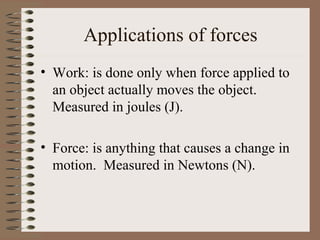Obj 3 forces that act on objects resulting in motion
•Als PPT, PDF herunterladen•
0 gefällt mir•881 views
Melden
Teilen
Melden
Teilen

Empfohlen
Empfohlen
Weitere ähnliche Inhalte
Was ist angesagt?
Was ist angesagt? (20)
Ähnlich wie Obj 3 forces that act on objects resulting in motion
Have you gone above the speed limit or driven without a license and gotten away? Well, you can’t get away with breaking the laws of physics! This session will highlight:
• Why loads rotate, shift and swing
• Load Stability and how to understand and control mobility
• Predicting outcomes of load moving based on physical laws
• Internal and external forces and restraint
• Choosing the most economical and practical equipment for a job
Speaker: Don Mahnke, President, Hydra-Slide, Ltd. 2017 CRW: Breakout Session 2: Unbreakable Laws: Physics of a Move 

2017 CRW: Breakout Session 2: Unbreakable Laws: Physics of a Move Specialized Carriers & Rigging Association
Ähnlich wie Obj 3 forces that act on objects resulting in motion (20)
2017 CRW: Breakout Session 2: Unbreakable Laws: Physics of a Move 

2017 CRW: Breakout Session 2: Unbreakable Laws: Physics of a Move
Mehr von Spencer56
Mehr von Spencer56 (20)
Obj 4 forms of energy and living organism's response (2)

Obj 4 forms of energy and living organism's response (2)
Obj 1 relationship between energy, force, and motion

Obj 1 relationship between energy, force, and motion
Obj 3 rock and fossil evidence used to infer earth's history

Obj 3 rock and fossil evidence used to infer earth's history
Obj 1&2 compare ways plants and animals use energy and how they are dependant

Obj 1&2 compare ways plants and animals use energy and how they are dependant
Obj 3 forces that act on objects resulting in motion
- 1. Applications of forces • Work: is done only when force applied to an object actually moves the object. Measured in joules (J). • Force: is anything that causes a change in motion. Measured in Newtons (N).
- 2. • Effort: Is the amount of force you apply to get work done. Measured in kilograms (kg). • Distance: is the amount of space an object moves. Measured in meters (m).
- 3. Work with a Machine • WORK STAYS THE SAME!!!! • Force is decreased. Less effort is applied. It is easier for work to be done. • Distance increases.
- 4. Without a machine • WORK STAYS THE SAME!!!! • Force increases. More effort is necessary. It is harder for work to be done • Distance decreases.
- 5. Levers • A simple machine consisting of a bar that pivots at a fixed point, called a fulcrum. • There are three classes of levers
- 6. 1st Class • The FULCRUM is always in between the input force and the out put force. • Mechanical Advantage: <1, =1, >1 • Examples: Crowbar, scissors, rowboat, teeter totter.
- 7. 2nd Class • The OUTPUT FORCE (LOAD) is always between the fulcrum and the input force. • Mechanical Advantage: >1 (greater than one) • Examples: Bottle opener, wheel barrow.
- 8. 3rd Class • The INPUT FORCE is always between the fulcrum and the output force (load). • Mechanical Advantage: <1 (less than one) • Examples: Barbells, hammer Fishing pole.
- 9. Types of Friction • Static Friction: when a force is applied to an object, but does not make it move
- 10. Types of Friction • Sliding: it opposes the movement of objects that are sliding.
- 11. Types of Friction • Rolling: a force that opposes a rolling object on another surface. It is less than sliding friction, so it is easier to move objects.
- 12. Types of Friction • Fluid: it opposes motion of objects traveling through a liquid or gas.
- 13. Air Resistance • It is fluid friction. It helps things fall more slowly.
- 14. Changing Force and Motion • Isaac Newton came up with three laws that explain why objects move or don’t move.
- 15. Changing Force and Motion • 1st Law: an object at rest remains at rest and an object in motion remains in motion at a constant speed and in a straight line unless acted on by an unbalanced force.
- 16. Changing Force and Motion • 2nd Law: the acceleration of an object depends on the mass of the object and the amount of force applied. • 3rd Law: whenever one object exerts a force on a second object, the second object exerts an equal and opposite force on the first.